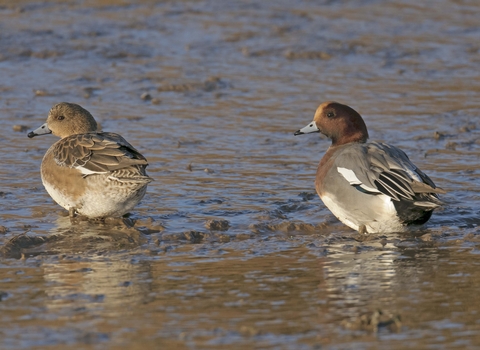
Female (left) and male (right) wigeon © Chris Gomersall/2020VISION
Wigeon
The wigeon is a colourful duck that can often be spotted wheeling round our winter skies in large flocks. A dabbling duck, it surface-feeds on plants and seeds in shallow waters.
Scientific name
Anas penelopeWhen to see
January to DecemberSpecies information
Category
Statistics
Length: 43-48cmWingspan: 80cm
Weight: 650-800g
Average lifespan: 3 years
Classified in the UK as Amber under the Birds of Conservation Concern 5: the Red List for Birds (2021). Protected in the UK under the Wildlife and Countryside Act, 1981.
Habitats
About
A common dabbling duck, the wigeon is a winter visitor that gathers in large numbers, particularly on wet grasslands, floodplain meadows, flooded gravel pits and reservoirs with gently sloping edges where they can easily get out onto the grassy banks. Wigeon can be spotted dabbling in close-knit groups or flying in tight formations over wetlands.How to identify
The wigeon is a medium-sized duck with a round head and short bill. Males are grey with a pink breast, orange head, yellow forehead and obvious white wing patches that can be seen when they fly. Females are similar to mallard females, but with rusty brown plumage and a pointed tail.Distribution
Found throughout the country in winter, with large numbers congregating in coastal areas. It breeds in Scotland and Northern England in very small numbers.In our area
Wigeon have been spotted at our Reserve Wood Lane.
Did you know?
Like other ducks, wigeon will sometimes mate with other species to produce hybrid young. This includes the closely related American wigeon, but also mallards and gadwalls.Watch
Wigeon flock (https://vimeo.com/642749826)
Tom Hibbert
Wigeon have been spotted at our Reserve Wood Lane.

